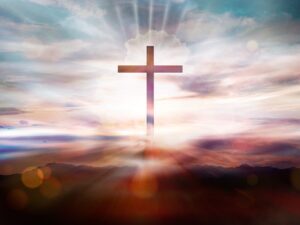Holy Week
In Christianity, Holy Week is the week after Lazarus Saturday, immediately preceding Easter. It is a moveable observance that falls on the last week of Lent.
Holy Week begins with the commemoration of Jesus’ triumphal entry into Jerusalem on Palm Sunday, climaxing with the Last Supper and Passion of Jesus on Good Friday, ending with his sabbath rest in the grave on Holy Saturday. The resurrection of Jesus on eighth day, is celebrated as Easter, and marks the beginning of a new week, Easter week and the season of Eastertide.
Palm Sunday
 Palm Sunday commemorates Christ’s triumphant arrival in Jerusalem to the cheers of the crowd.
Palm Sunday commemorates Christ’s triumphant arrival in Jerusalem to the cheers of the crowd.In Anglican and Roman Catholic churches, members of the congregation hold small crosses made of palm leaf, both to remember the palm leaves which the people of Jerusalem waved when Jesus arrived, and to remember the cross on which he died.
Some Christians display the crosses from that service in their homes during the year as a symbol of their faith. The crosses are burned at the start of Lent the next year to provide the ash for Ash Wednesday.
Maundy Thursday
 Maundy Thursday is the Thursday before Easter.
Maundy Thursday is the Thursday before Easter.The night of Maundy Thursday is the night on which Jesus was betrayed by Judas in the Garden of Gethsemane.
The word maundy comes from the command (mandate) given by Christ at the Last Supper, that we should love one another
Good Friday
Good Friday commemorates Jesus’ crucifixion
The most important events in Christianity are the death and later resurrection of Jesus Christ, who Christians believe is the Son of God, and whose life and teachings are the foundation of Christianity.
Good Friday is the Friday before Easter. It commemorates the Passion: the execution of Jesus by crucifixion.
Good Friday is a day of mourning in church. During special Good Friday services Christians meditate on Jesus’ suffering and death on the cross, and what this means for their faith.
In some countries, there are special Good Friday processions, or re-enactments of the Crucifixion.
The main service on Good Friday takes place between midday and 3pm. In many churches it takes the form of a meditation based on the seven last words of Jesus on the cross, with hymns, prayers, and short sermons.
 The last words from the cross
The last words from the cross
 Easter Sunday.
Easter Sunday.
The date of Easter changes each year, and several other Christian festivals fix their dates by reference to Easter.
The Easter story is at the heart of Christianity
The tomb was guarded and an enormous stone was put over the entrance, so that no-one could steal the body.
On the following Sunday, some women visited the grave and found that the stone had been moved, and that the tomb was empty.
Jesus himself was seen that day, and for days afterwards by many people.
His followers realised that God had raised Jesus from the dead.